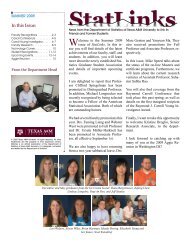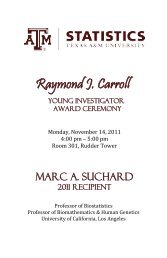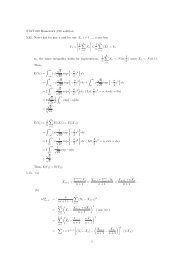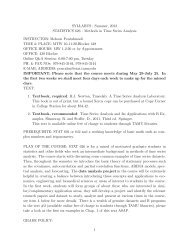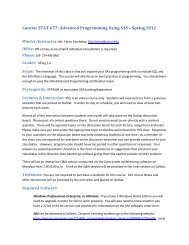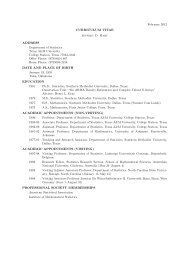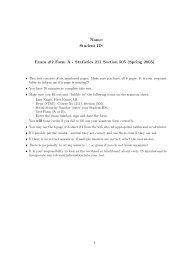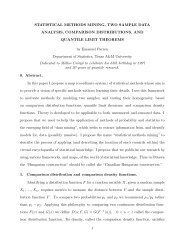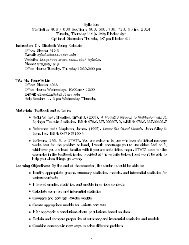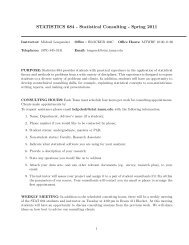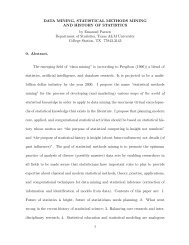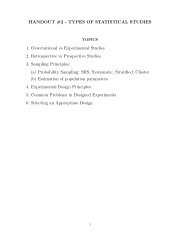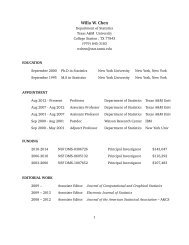Two-sample proportions
Two-sample proportions
Two-sample proportions
You also want an ePaper? Increase the reach of your titles
YUMPU automatically turns print PDFs into web optimized ePapers that Google loves.
Objectives <br />
8.2 Comparing two <strong>proportions</strong><br />
p<br />
Examples<br />
p<br />
Large-<strong>sample</strong> CI for a difference in <strong>proportions</strong><br />
p<br />
Significance test for a difference in <strong>proportions</strong><br />
p<br />
Relative risk<br />
Adapted from authors’ slides © 2012 W.H. Freeman and Company
Comparing <strong>proportions</strong> <br />
p<br />
q<br />
q<br />
q<br />
The one <strong>sample</strong> proportion case that we considered previously is<br />
important but a more example is when we want to compare<br />
between two populations.<br />
The applications traverse several areas from the social sciences to<br />
medicine.<br />
The main assumptions that we will be making is that the <strong>sample</strong>s<br />
are completely independent and as usual so as not to have a bias<br />
we assume that the <strong>sample</strong>s are SRS (simple random <strong>sample</strong> from<br />
the populations of interest).<br />
We start by looking at several motivating examples.
Motivation: Aggies verses Longhorns <br />
p<br />
p<br />
p<br />
A survey was done to see whether the proportion of people who<br />
support the Aggies (over the Longhorns) differ in small towns.<br />
A random <strong>sample</strong> people were interviewed in Hearn and Calvert<br />
(two small towns north of College Station).<br />
Of the 200 people <strong>sample</strong>d in Hearn 51% said they support the<br />
Aggies whereas of the 150 people <strong>sample</strong>d in Calvert 46% said they<br />
support the Aggies. Are there any differences in the towns?<br />
Aggies<br />
Longhorns<br />
Hearn 102 98<br />
Calvert 69 81<br />
Remember, theses are <strong>sample</strong>s from the populations, so 51% and 46% are simply<br />
estimates of the <strong>proportions</strong> over the entire town. What we want is to test<br />
H 0: p H – p C = 0 against H A: p H – p C ≠ 0, in other words in this difference we see in the<br />
<strong>sample</strong>s statistically significant.
Example 1: Differences in opinions <br />
p<br />
p<br />
Some suggest that people in the South have a different attitude<br />
towards renewable energy than those elsewhere in the country. A<br />
survey was conducted. 400 people were surveyed and asked should<br />
be government focus federal funding on renewable or nonrenewable<br />
energy resources.<br />
The results of the survey are given below.<br />
South<br />
Not South<br />
Renewable 130 145<br />
Not-renewable 70 55<br />
200 200<br />
From the data there is a difference in the <strong>proportions</strong>:<br />
ˆp S =0.65 and ˆp N =0.725<br />
But is this difference statistically significant?
p As we are only looking for a difference we are testing H 0: p S – p N = 0<br />
against H A: p S – p N ≠ 0.The results are given below.<br />
Hypothesis test results:<br />
p 1 : proportion of successes for population 1<br />
p 2 : proportion of successes for population 2<br />
p 1 − p 2 : difference in <strong>proportions</strong><br />
H 0 : p 1 − p 2 = 0<br />
H A : p 1 − p 2<br />
Difference Count1 Total1 Count2 Total2 Sample Diff. Std. Err. Z−Stat P−value<br />
p 1 − p 2 145 200 130 200 0.075 0.04635124 1.6180797 0.1056<br />
As the p-value is 10.56% (which is larger than the usual 5% significance level).<br />
Based on this there is a 10.56% chance of observing the difference by random<br />
chance, as this chance is quite large there isn’t anything in the data that suggests<br />
there is a difference in the opinions of the South and elsewhere.
Example 2: Dogs or Cats? <br />
p<br />
p<br />
p<br />
Popular belief is that males tend to be dog people and females tend<br />
to prefer cats. Is there any evidence that females really prefer cats?<br />
We want to test whether the proportion of females who like cats is<br />
greater than the proportion of males who like cats: H 0: p F – p M = 0<br />
against H A: p F – p M > 0.<br />
A simple random <strong>sample</strong> of 100 students were taken. The data is<br />
given below<br />
Guy<br />
Gal<br />
Cats 25 30<br />
Dogs 25 20<br />
50 50<br />
From this data, our estimate of the proportion of males who like cats = 0.5<br />
and the proportion of females who like cats is 0.6. There is a difference in preference<br />
in this <strong>sample</strong>, but is it statistically significant?
Hypothesis test results:<br />
p 1 : proportion of successes for population 1<br />
p 2 : proportion of successes for population 2<br />
p 1 − p 2 : difference in <strong>proportions</strong><br />
H 0 : p 1 − p 2 = 0<br />
H A : p 1 − p 2<br />
Difference Count1 Total1 Count2 Total2 Sample Diff. Std. Err. Z−Stat P−value<br />
p 1 − p 2 30 50 25 50 0.1 0.09949874 1.0050378 0.3149<br />
The above gives the output for a two-sided test, but we can deduce the p-value for<br />
our one-sided test. The above output is the area to the right of 1.005 multiplied by<br />
1.<br />
Returning to our test: We see that the z-transform for our test is the same as above:<br />
z = (0.6 – 0.5)/0.09 = 1.005.<br />
As our alternative hypothesis is H A :p F – p M >0, by cross checking this with the z-<br />
transform we see that our p-value is the area to the right of 1.005. So either looking<br />
up the tables or halving the above p-value the p-value for our test is 15.5%.<br />
Ie. There is a 15.5% chance of observing the differences we are seeing in the<br />
<strong>sample</strong> when there isn’t a difference in male female preference. As this is less than<br />
5%, there is no evidence to reject the null.<br />
Where do we believe the difference in the <strong>proportions</strong> lie, this is given by the<br />
confidence interval.
Below we construct a 95% confidence interval for the difference in preference.<br />
95% confidence interval results:<br />
p 1 : proportion of successes for population 1<br />
p 2 : proportion of successes for population 2<br />
p 1 − p 2 : difference in <strong>proportions</strong><br />
Difference Count1 Total1 Count2 Total2 Sample Diff. Std. Err. L. Limit U. Limit<br />
p 1 − p 2 30 50 25 50 0.1 0.09899495 −0.094026536 0.29402652<br />
We see from the output that the 95% confidence interval for the difference<br />
between true <strong>proportions</strong> of males and females who prefer cats lies somewhere<br />
between [-0.09,0.29].
Example 3: Thai HIV vaccine trials <br />
p<br />
p<br />
In 2006 drug trials were done for a vaccine against HIV.<br />
16,000 volunteers in Thailand were put on the trial, 8000 given the<br />
vaccine and 8000 a placebo: http://en.wikipedia.org/wiki/RV_144<br />
vaccine<br />
placebo<br />
Contracted HIV 51 72<br />
Did not 7949 7968<br />
Total 8000 8000<br />
q Clearly the vaccine is not effective, in the sense that some of of the<br />
people given the drug went on to develop HIV, but there in this <strong>sample</strong><br />
the proportion of people who were given the vaccine and went on to<br />
develop HIV is slightly less than those who were not given the vaccine:<br />
ˆp V =0.0065 and ˆp P =0.009<br />
Is this difference statistically significant?
Hypothesis test results:<br />
p 1 : proportion of successes for population 1<br />
p 2 : proportion of successes for population 2<br />
p 1 − p 2 : difference in <strong>proportions</strong><br />
H 0 : p 1 − p 2 = 0<br />
H A : p 1 − p 2 > 0<br />
Difference Count1 Total1 Count2 Total2 Sample Diff. Std. Err. Z−Stat P−value<br />
p 1 − p 2 74 8000 51 8000 0.002875 0.0013920726 2.065266 0.0194<br />
q Here we are testing H 0: p P – p V = 0 against H A: p P – p V > 0.<br />
q<br />
This matches with the test above and the p-value is 1.94%. This suggests that<br />
though the difference between the two groups is small it is still significant, and it<br />
is plausible that the vaccine does have some protective effect.<br />
q<br />
There has been a lot of criticism in how this trial was done, in particular that it<br />
should have targeted vulnerable groups such as sex workers, as their chance of<br />
contracting HIV tends to larger. This allows to really test the efficacy of the<br />
vaccine.
Example 4: SA HIV vaccine trials <br />
p<br />
p<br />
p<br />
In 2005 drug trials were done for a vaccine against HIV.<br />
About 1800 men in South Africa were put on the trial.<br />
http://en.wikipedia.org/wiki/STEP_study<br />
vaccine<br />
placebo<br />
Contracted HIV 49 33<br />
Did not 865 889<br />
Total 914 922<br />
q<br />
Look at the <strong>proportions</strong>,<br />
ˆp V =0.053 and ˆp P =0.035<br />
It is immediately clear that the data does not suggest the vaccine is working.<br />
In 2007, in light of what they were seeing, the trial was immediately abandoned.<br />
Some suggest that the vaccine may even have had a negative effect….is<br />
there???
Example 5: Hair remedies <br />
p<br />
A drug firm wants to test the efficacy of a hair cream on increasing<br />
hair. They did a randomized trial, one group was given the drug and<br />
the other was given a placebo. They are interested in testing:<br />
Minodixil Placebo<br />
See a difference 99 60<br />
No difference 211 242<br />
310 302<br />
q<br />
Based on the above <strong>sample</strong> the estimates of the <strong>proportions</strong> are<br />
ˆp M =0.32 and ˆp P =0.2<br />
There is a difference in <strong>sample</strong> <strong>proportions</strong>, the question is can this difference be<br />
explained by random sampling or is it statistically significant?
Hypothesis test results:<br />
p 1 : proportion of successes for population 1<br />
p 2 : proportion of successes for population 2<br />
p 1 − p 2 : difference in <strong>proportions</strong><br />
H 0 : p 1 − p 2 = 0<br />
H A : p 1 − p 2 > 0<br />
Difference Count1 Total1 Count2 Total2 Sample Diff. Std. Err. Z−Stat P−value<br />
p 1 − p 2 99 310 60 302 0.12067934 0.035455827 3.4036531 0.0003<br />
Clearly the firm wants to see whether their remedy is better than the placebo so<br />
they are testing H 0: p M – p P = 0 against H A: p M – p P > 0.<br />
The above is a one-sided test that corresponds to the above test (just make sure<br />
you enter the data in correctly).<br />
q The p-value is 0.03%, which is less than the standard significance levels, thus<br />
there is evidence to suggest that Minodixil works.
Comparing two independent <strong>sample</strong>s <br />
The main assumption made when doing the tests and making<br />
confidence intervals in the previous example is that the difference<br />
between the two <strong>sample</strong> proportion<br />
normally distributed.<br />
pˆ − pˆ . is approximately<br />
1 2
Test of signiJicance for H 0 : p 1 = p 2 <br />
If the null hypothesis is true, then we can rely on the properties of the<br />
sampling distribution to estimate the probability of drawing 2 <strong>sample</strong>s<br />
with <strong>proportions</strong> pˆ 1 and pˆ<br />
2 at random. The null hypothesis says<br />
p 1 = p 2 = p, with p denoting the common value.<br />
Our best estimate of p is the pooled <strong>sample</strong> proportion:<br />
total successes count1+ count2 X<br />
ˆ<br />
1+<br />
X2<br />
p = = = .<br />
total observations n + n n + n<br />
The test statistic is then<br />
z<br />
=<br />
pˆ1−<br />
pˆ2<br />
.<br />
⎛⎛ 1 1 ⎞⎞<br />
pˆ(1 − pˆ)<br />
⎜⎜ + ⎟⎟<br />
⎝⎝n1 n2<br />
⎠⎠<br />
1 2 1 2<br />
⎛⎛ 1 1<br />
p(1 − p)<br />
⎜⎜ +<br />
⎝⎝n1 n2<br />
⎞⎞<br />
⎟⎟<br />
⎠⎠<br />
=0<br />
This test is appropriate when the populations are at least 10 times as<br />
large as the <strong>sample</strong>s and all counts are at least 5 (number of<br />
successes and number of failures in each <strong>sample</strong>).
Of course the p proportion is unknown even under the null. The estimate of the<br />
proportion by pooling the <strong>sample</strong>s is<br />
ˆp =<br />
no. of successes in <strong>sample</strong> 1 plus number of successes in <strong>sample</strong> 2<br />
no. in <strong>sample</strong> 1 plus no. in <strong>sample</strong> two<br />
Therefore standard error for the test then becomes<br />
s.e. =<br />
s<br />
ˆp(1<br />
✓ 1<br />
ˆp)<br />
m n◆<br />
+ 1
Large-‐<strong>sample</strong> CI for two <strong>proportions</strong> <br />
For two independent SRSs of sizes n 1 and n 2 with <strong>sample</strong> proportion<br />
pˆ<br />
pˆ<br />
of successes 1 and 2<br />
confidence interval for p 1 – p 2 is<br />
respectively, an approximate level C<br />
( pˆ<br />
− pˆ<br />
) ± m, m is the margin of error<br />
1 2<br />
pˆ (1 − pˆ ) pˆ (1 − pˆ<br />
)<br />
m = z × SE = z × +<br />
* * 1 1 2 2<br />
diff<br />
n1 n2<br />
C is the area under the standard normal curve between −z* and z*.<br />
Use this method only when the populations are at least 10 times larger<br />
than the <strong>sample</strong>s and the number of successes and the number of<br />
failures are each at least 10 in each <strong>sample</strong>.
Example 5: standard errors and hair remedies <br />
p<br />
A drug firm wants to test the efficacy of a hair cream on increasing<br />
hair. Comparing with a placebo in a randomized trial we have<br />
Minodixil Placebo<br />
See a difference 99 60<br />
No difference 211 142<br />
310 302<br />
q<br />
Based on the above <strong>sample</strong> the estimates of the <strong>proportions</strong> are<br />
ˆp M =0.32 and ˆp P =0.2<br />
q<br />
The standard error to construct a confidence interval is<br />
s.e. =<br />
r<br />
(99/310)(211/310)<br />
310<br />
+ (60/302)(142/302)<br />
302<br />
=0.035
Example 5: conJidence intervals <br />
p<br />
Using this standard error the 95% confidence interval for the<br />
difference between the remedies is<br />
[(0.32 0.2) 1.96 ⇥ 0.035, (0.32 0.2) + 1.96 ⇥ 0.035] = [0.0514, 0.1886]<br />
The above gives the proportion gain in using Minodixil over the Placebo. Ie,<br />
between 5% to 18.9% of population would notice a difference over using a<br />
placebo.
Example 5: standard errors for the test <br />
q If we are testing H 0: p M – p P = 0 against H A: p M – p P > 0.<br />
The pooled proportion estimate is<br />
99 + 60<br />
ˆp =<br />
310 + 302 = 159<br />
612 =0.259<br />
q This gives the standard error<br />
s.e. =<br />
s<br />
✓ 1<br />
(159/612)(453/612)<br />
310 + 1 ◆<br />
302<br />
=0.0354
Different standard errors for CI and tests <br />
p<br />
p<br />
p<br />
p<br />
From the output given in the previous examples, you may have<br />
noticed that the standard errors for the CI and the test are different<br />
(similar to the one-proportion case but different to the mean<br />
examples that we encountered previously).<br />
The `true’ standard in the two <strong>sample</strong> case is<br />
v<br />
u<br />
t<br />
p 1 (1 p 1 )<br />
n<br />
| {z }<br />
first <strong>sample</strong><br />
+ p 2(1 p 2 )<br />
m<br />
| {z }<br />
second <strong>sample</strong><br />
But of course the <strong>proportions</strong> are unknown and need to be replaced<br />
by the estimates based on the <strong>sample</strong>s.<br />
In the case of constructing confidence intervals we estimate the<br />
proportion for each <strong>sample</strong> and use:<br />
v<br />
ˆp 1 (1 ˆp 1 )<br />
u + ˆp 2(1 ˆp 2 )<br />
t<br />
| {z<br />
n<br />
} | {z<br />
m<br />
}<br />
first <strong>sample</strong> second <strong>sample</strong>
p<br />
However, in the case of hypothesis testing H 0: p 1 – p 2 = 0 against<br />
H A: p 1 – p 2 > 0. We construct the standard error under the null.<br />
Under the null the <strong>proportions</strong> for both populations are assumed to<br />
be the same, in this case the standard error becomes<br />
s ✓ 1<br />
p(1 p)<br />
m n◆<br />
+ 1<br />
Of course the p proportion is unknown even under the null. But in this case we<br />
`pool’ the two <strong>sample</strong>s to obtain an estimator of p:<br />
ˆp =<br />
no. of successes in <strong>sample</strong> 1 plus number of successes in <strong>sample</strong> 2<br />
no. in <strong>sample</strong> 1 plus no. in <strong>sample</strong> two<br />
To understand why we `pool’ the <strong>sample</strong>s to get an estimator under the<br />
null both <strong>proportions</strong> are the same, consider the following example.<br />
q Suppose we want to estimate the proportion of students who use a<br />
cell phone. It was found that in a <strong>sample</strong> of 300 junior students 250<br />
used a cell phone and in a <strong>sample</strong> of 360 senior student 310 students<br />
used a cell phone. If we don’t think there is any difference between<br />
juniors and seniors the estimator of the proportion will be<br />
(250+310)/(360+300). We have `pooled’ the data.
Calculation Practice: Cholesterol and heart attacks <br />
How much does the cholesterol-lowering drug Gemfibrozil help reduce the risk<br />
of heart attack? We compare the incidence of heart attack over a 5-year period<br />
for two random <strong>sample</strong>s of middle-aged men taking either the drug or a placebo.<br />
Standard error of the difference p G − p P :<br />
pˆG(1 − pˆG) pˆP(1 − pˆP)<br />
SE = +<br />
n n<br />
G<br />
P<br />
Heart<br />
attack<br />
Sample<br />
size<br />
Proportion<br />
Gemfibrozil 56 2051 2.73%<br />
Placebo 84 2030 4.14%<br />
0.0273(0.9727) 0.0414(0.9586)<br />
SE = + = 0.000325 = 0.00570.<br />
2051 2030<br />
The confidence interval is ( pˆ<br />
− pˆ<br />
) ± z × SE.<br />
So a 90% CI is (0.0273 − 0.0414) ± 1.645×0.0057 = −0.0141 ± 0.0094, or<br />
(−0.0235, −0.0047).<br />
We estimate with 90% confidence that the percentage of middle-aged men<br />
who suffer a heart attack is 0.47% to 2.35% lower when taking the cholesterollowering<br />
drug.<br />
G<br />
P<br />
*
Calculation Practice: Cholesterol and heart attacks, cont. <br />
Does (in fact) the cholesterol-lowering drug Gemfibrozil help reduce the risk of<br />
heart attack? We want to test the hypotheses<br />
H 0 : p G = p P vs. H a : p G < p P , with α = 0.01.<br />
The pooled estimate is<br />
XG<br />
+ XP<br />
56 + 84<br />
pˆ = = = 0.0343,<br />
n + n 2051+<br />
2030<br />
G<br />
P<br />
Heart<br />
attack<br />
Sample<br />
size<br />
Proportion<br />
Gemfibrozil 56 2051 2.73%<br />
Placebo 84 2030 4.14%<br />
pˆ<br />
and so the standard error is<br />
0.0343(0.9657) 0.0343(0.9657)<br />
SE = + = 0.000325 = 0.00570.<br />
2051 2030<br />
pˆG<br />
− pˆ P .0273 −.0414<br />
The test statistic is z = = =−2.475.<br />
SE .00570<br />
So the P-value is 0.0067 < 0.01.<br />
We conclude that the percentage of middle-aged men who suffer a heart attack<br />
is lower when taking the Gemfibrozil, compared to the placebo.
Cholesterol and heart attacks, cont. <br />
From StatCrunch: Stat-Proportions-<strong>Two</strong> <strong>sample</strong>-With summary
Calculation Practice: Gastric Freezing<br />
Gastric freezing was once a treatment for ulcers. Patients would<br />
swallow a deflated balloon with tubes, and a cold liquid would be<br />
pumped for an hour to cool the stomach and reduce acid production,<br />
thus relieving ulcer pain. The treatment was shown to be safe,<br />
significantly reducing ulcer pain, and was widely used for years.<br />
A randomized comparative experiment later compared the outcome of gastric<br />
freezing with that of a placebo: 28 of the 82 patients subjected to gastric<br />
freezing improved, while 30 of the 78 in the control group improved.<br />
H 0 : p gf = p placebo<br />
H a : p gf > p placebo<br />
pˆgf<br />
− pˆplacebo<br />
0.3415 −0.3846 −0.0432<br />
z = = = =−0.568.<br />
⎛⎛ 1 1 ⎞⎞ ⎛⎛ 1 1 ⎞⎞ 0.2311×<br />
0.02502<br />
pˆ(1 − pˆ)<br />
⎜⎜ + ⎟⎟ 0.3625× 0.6375× ⎜⎜ + ⎟⎟<br />
⎝⎝n<br />
82 78<br />
1 n2<br />
⎠⎠<br />
⎝⎝ ⎠⎠<br />
The P-value for the test is P(Z > −0.568) = 0.715.<br />
28 + 30<br />
pˆ = pˆpooled<br />
= = 0.3625.<br />
82 + 78<br />
Conclusion: The gastric freezing was no better than a placebo. Consequently,<br />
the treatment was abandoned. Moral: ALWAYS USE A CONTROL GROUP!
Summary of inference for p 1 − p 2 <br />
p<br />
p<br />
p<br />
p<br />
p<br />
The estimate for p 1 − p 2 is the difference in <strong>sample</strong> <strong>proportions</strong><br />
pˆ − pˆ .<br />
1 2<br />
The confidence interval for a population proportion p 1 − p 2 is<br />
* pˆ1(1 −pˆ1) pˆ2(1 −pˆ2)<br />
pˆ1− pˆ 2 ± z + .<br />
n1 n2<br />
z* is obtained from the normal distribution for confidence level C.<br />
A significance test of the hypothesis H 0 : p 1 = p 2 uses test statistic<br />
pˆ<br />
− pˆ<br />
X + X<br />
z= , with = .<br />
1 2 1 2<br />
pˆ<br />
pˆ(1 −pˆ) pˆ(1 −pˆ)<br />
+<br />
n1+<br />
n2<br />
n n<br />
1 2<br />
The P-value is computed from the normal distribution according to the<br />
alternative hypothesis.<br />
Note the distinction between the SE for a confidence interval and the<br />
SE for a hypothesis test.<br />
The investigator chooses the confidence level C and/or the<br />
significance level α prior to viewing the data.
Brief introduction to relative risk <br />
Another way to compare two <strong>proportions</strong> is to study the ratio of the two<br />
<strong>proportions</strong>, which is often called the relative risk (RR). A relative risk<br />
of 1 means that the two <strong>proportions</strong> are equal.<br />
The procedure for calculating confidence intervals for relative risk is<br />
more complicated (use software) but still based on the same principles<br />
that we have studied.<br />
The age at which a woman gives birth to her first child may be an important<br />
factor in the risk of later developing breast cancer. An international study<br />
selected women with at least one birth and recorded if they had breast cancer<br />
or not and whether they had their first child before their 30 th birthday or after.<br />
Age at birth<br />
of 1 st child<br />
Number with<br />
cancer<br />
Sample size<br />
Proportion<br />
30+ 683 3220 21.2%<br />



